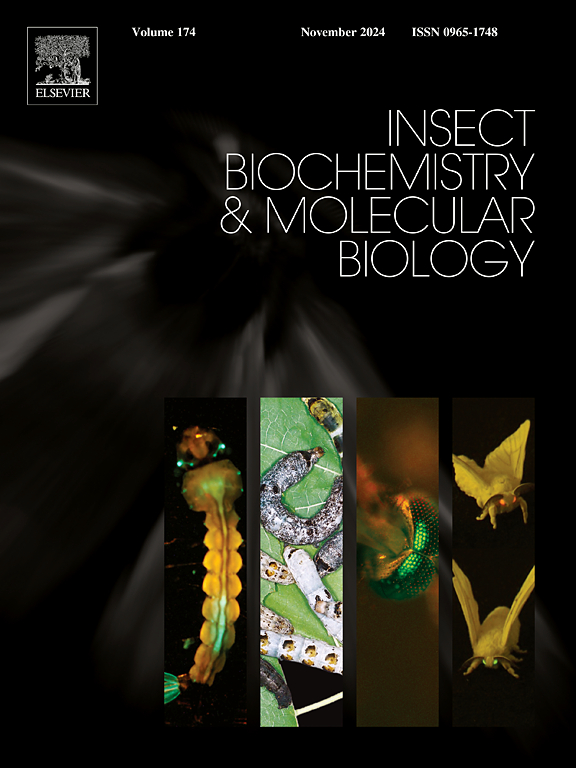SRBSDV感染对WBPH唾液分泌影响的蛋白质组学和转录组学分析。
IF 3.7
2区 农林科学
Q2 BIOCHEMISTRY & MOLECULAR BIOLOGY
引用次数: 0
摘要
大多数植物病毒依靠昆虫媒介传播,昆虫唾液是病毒-媒介-宿主三方相互作用的关键界面。南方水稻黑条纹矮病毒(SRBSDV)是一种由白背飞虱(Sogatella furcifera, WBPH)传播的破坏性病原体,严重威胁水稻生产,但SRBSDV操纵白背飞虱唾液分泌促进病毒传播的机制尚不清楚。综合蛋白质组学和转录组学分析显示,SRBSDV感染显著降低了WBPH中唾液蛋白的多样性和丰度,包括消化酶、氧化还原调节因子和抑制植物防御的关键效应蛋白。LC-MS/ ms为基础的定量分析显示,与srbsdv不存在的对照组相比,srbsdv感染的WBPH分泌的蛋白类型和丰度谱显著下降。转录组学分析在srbsdv感染的唾液腺中发现了1803个差异表达基因,其中跨膜运输相关通路显著下调。至关重要的是,交叉组学整合揭示了唾液蛋白分泌与转录变化之间的最小相关性,这表明SRBSDV主要通过损害跨膜运输能力而不是直接抑制蛋白质合成来破坏唾液功能。这种分泌缺陷可能削弱了昆虫中和植物防御的能力,促使行为转变为频繁探测,提高病毒接种效率。我们的研究揭示了SRBSDV劫持载体分泌机制以优化传播的新策略,促进了对病毒-载体协同进化的理解,并为阻断病毒传播的效应靶向干预提供了基础。本文章由计算机程序翻译,如有差异,请以英文原文为准。

Proteomic and transcriptomic analysis of the effects of SRBSDV infection on saliva secretion in WBPH
Most plant viruses rely on insect vectors for transmission, with insect saliva serving as a critical interface in tripartite virus-vector-host interactions. Southern rice black-streaked dwarf virus (SRBSDV), a destructive pathogen transmitted by the white-backed planthopper (Sogatella furcifera, WBPH), severely threatens rice production, yet the mechanisms by which SRBSDV manipulates WBPH salivary secretion to enhance viral spread remain poorly understood. Here, integrated proteomic and transcriptomic analyses revealed that SRBSDV infection significantly reduces salivary protein diversity and abundance in WBPH, including digestive enzymes, redox regulators, and effector proteins critical for suppressing plant defenses. LC-MS/MS-based quantification demonstrated a marked decline in secreted protein types and altered abundance profiles in SRBSDV-infected WBPH compared to SRBSDV-free counterparts. Transcriptomic profiling identified 1803 differentially expressed genes in SRBSDV-infected salivary glands, with transmembrane transport-related pathways being prominently downregulated. Crucially, cross-omics integration revealed minimal correlation between salivary protein secretion and transcriptional changes, suggesting that SRBSDV primarily disrupts salivary function by impairing transmembrane transport capacity rather than directly suppressing protein synthesis. This secretory defect likely attenuates the insect's ability to neutralize plant defenses, driving behavioral shifts toward frequent probing that enhance viral inoculation efficiency. Our study unveils a novel strategy whereby SRBSDV hijacks vector secretory machinery to optimize transmission, advancing understanding of virus-vector coevolution and providing a foundation for effector-targeted interventions to block viral spread.
求助全文
通过发布文献求助,成功后即可免费获取论文全文。
去求助
来源期刊
CiteScore
7.40
自引率
5.30%
发文量
105
审稿时长
40 days
期刊介绍:
This international journal publishes original contributions and mini-reviews in the fields of insect biochemistry and insect molecular biology. Main areas of interest are neurochemistry, hormone and pheromone biochemistry, enzymes and metabolism, hormone action and gene regulation, gene characterization and structure, pharmacology, immunology and cell and tissue culture. Papers on the biochemistry and molecular biology of other groups of arthropods are published if of general interest to the readership. Technique papers will be considered for publication if they significantly advance the field of insect biochemistry and molecular biology in the opinion of the Editors and Editorial Board.

 求助内容:
求助内容: 应助结果提醒方式:
应助结果提醒方式:


